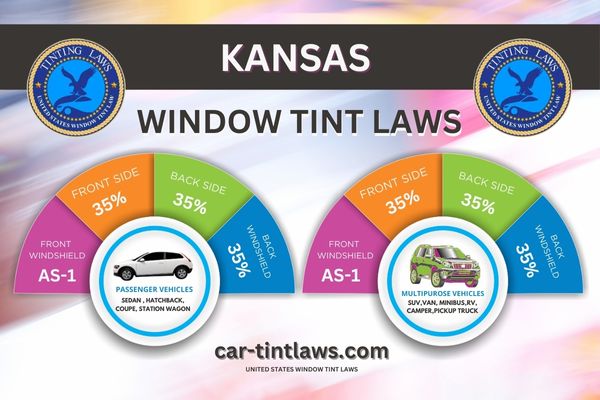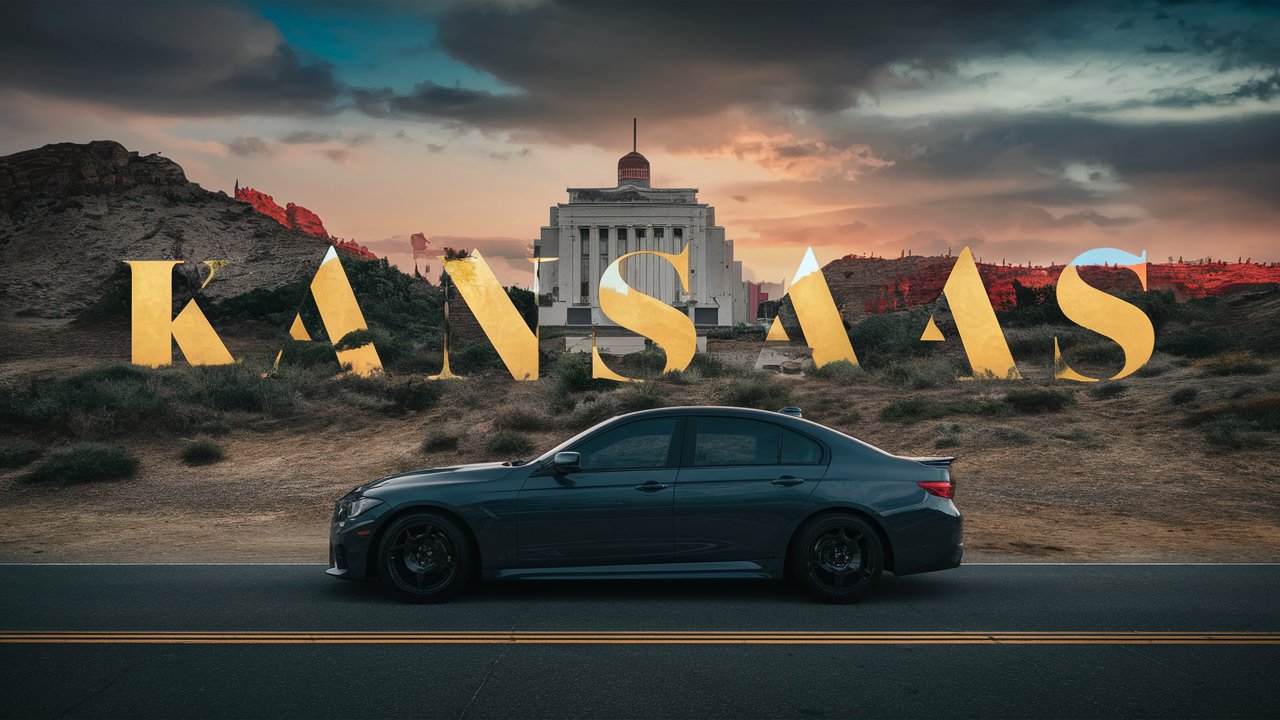When thinking about tinting your vehicle’s windows in Kansas, it’s essential to understand the specific regulations that apply.
You won’t want to get caught with windows that don’t comply, as it can result in fines and safety concerns.
Did you know that front side windows on sedans must allow more than 70% of light in, while back side and rear windows have slightly different requirements?
What’s more, reflective tints have their own set of rules, and medical exemptions are possible with proper documentation.
But what exactly do these allowances and restrictions mean for your vehicle?
Window Tint Darkness in Kansas
When considering window tint darkness in Kansas, it’s important to differentiate between regulations for sedans and those for SUVs and vans.
For sedans, front side windows must allow over 70% of light in, while back side and rear windows can be tinted to permit more than 35% of light.
In contrast, SUVs and vans must also adhere to the 70% VLT for front side windows, but they have more flexibility with back side and rear windows, which can allow a lower percentage of light in.
Tint darkness for sedans:
- Windshield: Non-reflective tint is allowed on the top 6 inches of the windshield.
- Front Side windows: Must have a visible light transmission of over 70%.
- Back Side windows: Must allow more than 35% of light in.
- Rear Window: Must allow more than 35% of light in.
Tint darkness for SUV and Vans:
- Windshield: Non-reflective tint is allowed on the top 6 inches of the windshield.
- Front Side windows: Must allow more than 35% of light in.
- Back Side windows: Must allow more than 35% of light in.
- Rear window: Any shade can be used
Window Tint Reflection in Kansas
When it comes to window tint reflection in Kansas, it’s important to know that the law differentiates between sedans and larger vehicles like SUVs and vans.
For sedans, the window tint must not be reflective to avoid causing glare that can distract other drivers.
Similarly, SUVs and vans also need to adhere to the non-reflective tint requirement, ensuring consistent visibility and safety for everyone on the road.
Tint reflection for sedans:
- Front Side windows: Must not be more than 20% reflective.
- Back Side windows: Must not be more than 20% reflective.
Tint reflection for SUV and vans:
- Front Side windows: Reflective tints are not allowed on SUVs and vans in Kansas.
- Back Side windows: Reflective tints are prohibited on SUVs and vans to ensure visibility and safety while driving.
Other Kansas window tint rules and regulations
- Side Mirrors: No restrictions.
- Restricted Colors: In Kansas, all tint colors are permitted.
- Certificates: Manufacturers of film need to certify the film they sell in the state. Ask your dealer if they are using certified film.
- Stickers: The sticker/label of compliance to identify legal tinting is required between the film & glass on each tinted window.
- Medical Exceptions: Kansas allows medical exemptions for special tint. For more details about the specific terms of the exemption, consult Kansas state law.
- Penalties: Violating Kansas window tint laws can result in fines. Ticket costs vary based on the offense, so it’s important to ensure compliance to avoid penalties.

Medical Exemptions for Window Tint Rules in Kansas
Obtaining a medical exemption for window tint in Kansas requires proper documentation from a physician and approval for compliance.
If you have specific medical conditions that necessitate darker tint levels, Kansas allows such exemptions.
To qualify, you’ll need to provide proper documentation that outlines your medical need for the exemption.
Conditions like light sensitivity or skin issues requiring UV protection are among the reasons you might be granted this special consideration.
Once you’ve secured the necessary paperwork from your physician, you must submit it for approval.
This approval is vital, as it ensures you comply with the state’s window tint rules while addressing your medical needs.
It’s important to keep the approved documentation in your vehicle at all times. This way, if you’re ever questioned by law enforcement, you can easily prove your exemption status.
In Kansas, the process is straightforward but must be followed to the letter. Proper documentation and adherence to the rules are necessary.
By making sure you have all the required paperwork, you can legally use darker window tints without facing penalties, making it easier to manage your medical condition while driving.
Kansas Window Tint Ticket Cost
If you’re caught with illegal window tint in Kansas, expect to pay a fine of $96.50.
Kansas window tint laws are strict about how much light transmission your windows must allow, especially for front side windows and windshields, which need over 70% light transmission.
This law aims to guarantee visibility and safety for all drivers on the road.
In Wichita alone, 43 tickets were issued in 2022 for illegal window tints, highlighting the significance of knowing and following these regulations.
The ticket cost might seem steep, but it serves as a deterrent to prevent potential safety risks associated with overly dark tints.
Law enforcement vehicles may be exempt from certain tint regulations in Kansas, but this doesn’t apply to regular drivers.
It’s important to adhere to the legal tint levels to avoid penalties and promote road safety.
Remember, the primary goal of these laws is to maintain clear visibility for drivers, reducing the chances of accidents.
If you’re considering tinting your windows, make sure to check the specific legal requirements in Kansas to avoid unnecessary fines and contribute to safer driving conditions for everyone.
Kansas Regulatory Details
When considering Kansas window tinting laws, you’ll need to understand the specific regulations regarding tint darkness limits, reflectivity restrictions, and medical exemptions.
Tint darkness must allow over 70% light transmission on front side windows and windshields, while other windows should permit more than 35% light.
Reflective tints are not allowed, and there are specific exemptions for medical conditions that may require different standards.
Tint Darkness Limits
In Kansas, you must have window tint that allows more than 35% of light to pass through all windows.
This means that the tint darkness must be such that it permits sufficient light transmission for visibility and safety.
Tint darkness is measured using a percentage known as Visible Light Transmission (VLT), which indicates how much light can pass through the tint film and glass.
For front side windows and the windshield, the law is even stricter, requiring over 70% light transmission to guarantee drivers maintain clear visibility of the road.
Moreover, it is essential to mention that any tint applied to the windshield must not extend beyond the AS1 line, a marking found on the glass that designates the boundary for legal tint application.
Staying within these limits ensures compliance with Kansas law and avoids potential fines.
Reflectivity Restrictions
Kansas law strictly prohibits the use of metallic or mirrored reflective tints on all vehicle windows. Whether you’re considering front side windows, back side windows, or the rear window, reflective tints aren’t allowed.
This regulation is in place to optimize both driver and pedestrian safety by maintaining ideal visibility.
Reflective tints can cause significant glare, which can reduce a driver’s ability to see clearly, especially in bright light conditions.
The laws emphasize the necessity of non-reflective window tints. These tints are designed to prevent glare and maintain clear visibility, optimizing that everyone on the road can travel safely.
It’s important to understand that the primary goal of these laws is to enhance safety by reducing the risks associated with reflective tints.
When windows have reflective properties, they can create distractions and obscure the view, posing a danger not only to the driver but also to other road users.
Medical Exemptions
Although Kansas has strict window tinting laws, you can acquire a medical exception with a doctor’s prescription.
This exception allows for darker tint levels than the standard legal limits, providing necessary UV protection for individuals with light-sensitive conditions.
To qualify for a medical exception, you must have a signed prescription from a licensed healthcare provider.
This prescription should detail the need for increased UV protection due to a medical condition.
Once you have the exception, you must carry it in your vehicle at all times. Law enforcement officers can request to see this documentation during a traffic stop or inspection.
Without it, you may be subject to penalties for violating Kansas window tint laws.
Medical exceptions are particularly beneficial for those with conditions like lupus, albinism, or other disorders that make one sensitive to sunlight.
These exceptions guarantee that you can drive comfortably and safely without risking your health.
It’s important to follow the state’s regulatory details precisely to maintain this privilege and avoid legal issues.
Always keep your exception paperwork readily accessible, so you’re prepared if questioned about your window tint levels.
References
Kansas Statutes Chapter 8 Article 17: se Cections 8-1749a through 8-1749c
Kansas Highway Patrol – Window Tint (.PDF file)
Frequently Asked Questions
What Is the Darkest Legal Tint in Kansas?
You’re wondering about the darkest legal tint in Kansas?
It’s 35% VLT. This balance guarantees there’s safety concerns and visual clarity, plus benefits like heat reduction, UV protection, privacy, aesthetics, and easy maintenance for longevity.
What Are the Tint Laws in Kansas 2024?
Imagine your car as a loyal knight, its tint percentage as armor. For 2024, all vehicle types must comply with police enforcement, tint inspection rules, and medical exemptions.
Your knight’s protection shouldn’t exceed legal limits.
How Much Is a Tint Ticket in Kansas?
You’ll face a fine amount of $96.50 for a tint ticket in Kansas.
Verify your tint percentage and tint darkness comply with regulations, or you might need a tint inspection or tint removal to avoid penalties.
Can You Get a Tint Exemption in Kansas?
Sure, you can get a tint exemption in Kansas.
Just provide medical reasons, like needing extra sun protection. After passing the vehicle inspection, you’ll legally go beyond the usual limits.
Conclusion
It’s essential to adhere to Kansas window tinting laws to guarantee your vehicle complies with legal standards.
Remember, ‘prevention is better than cure.’ Front side windows must permit more than 70% of light, while back side and rear windows can be tinted darker, permitting over 35% of light.
Reflective tints are not allowed, but there are endless color choices available. Following these rules helps uphold excellent visibility and road safety, preventing fines and legal complications.
